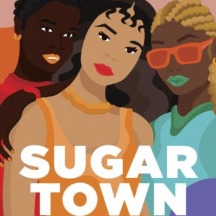"Sugar Town Queens" tells the story of Amandla, a 15-year-old mixed race South African girl, living on the edge of hunger in a Black shantytown, with her White mother. Her mother totters between reality and the life she lost years earlier. The story takes wings when Amandla discovers in her mother’s pocket book a large wad of cash with a strange address located in the mostly White city.
With her friends’ encouragement, Amandla heads into the city, hoping to discover the truth about her mentally unstable mother and unknown father. This city building is well guarded, but Amanda finds a surprising way in. Once there, she gradually uncovers the racist events that her mother had buried long ago and that continue to tear her apart.
To unmask more truths, Amandla must keep returning, but the obstacles grow. She asks over and over again, ”What can a Coloured girl from the township do to a White man who has all the power?” The answer becomes clear, as the reader watches Amandla finding a different kind of power growing within her, as she challenges adult authority again and again and finally dares to create a place of peace for her mother, herself, and others.
"Sugar Town Queens" is at its heart a story of what South Africans call ubuntu–love and strength in action—of the love between mothers and daughters, of friends helping friends, and of a broken family beginning to form new bonds.
Book Review: Sugar Town Queens

A favorite aspect of this story is the character development of the teenage friends. All three of the "Sugar Town Queens" are complex and multifaceted young women. In the final part, a budding attraction develops between two of them.
An author’s challenge when writing about a place unfamiliar to its readers is to make the place and people feel as if we’ve known them all along—that we have walked down the shantytown streets and that we recognize Amandla’s neighbor as someone we’d be glad to have as a friend. Through skillful descriptions and vivid characters, the author challenges the homogeneity that often comes to mind when outsiders think of people living in poverty in Africa.
The novel does an excellent job of conveying the naturalized levels of segregation that continue to permeate space in “the new South Africa” through its descriptions of travel and time navigating the city to and from Sugar Town.
There was one small oddity: from time to time the main character refers to Nelson Mandela as “Nelson,” a jarring form of address for an elder.
This quibble aside, it’s a wonderful read about courage and love in the face of racism and male power.
An author’s challenge when writing about a place unfamiliar to its readers is to make the place and people feel as if we’ve known them all along—that we have walked down the shantytown streets and that we recognize Amandla’s neighbor as someone we’d be glad to have as a friend. Through skillful descriptions and vivid characters, the author challenges the homogeneity that often comes to mind when outsiders think of people living in poverty in Africa.
The novel does an excellent job of conveying the naturalized levels of segregation that continue to permeate space in “the new South Africa” through its descriptions of travel and time navigating the city to and from Sugar Town.
There was one small oddity: from time to time the main character refers to Nelson Mandela as “Nelson,” a jarring form of address for an elder.
This quibble aside, it’s a wonderful read about courage and love in the face of racism and male power.
Advertisers | Contact Us | Events | Links | Media Kit | Our Company | Payments Pier
Press Room | Print Cover Stories Archives | Electronic Issues and Talk Radio Archives | Writer's Guidelines






